#palaeblr
Text
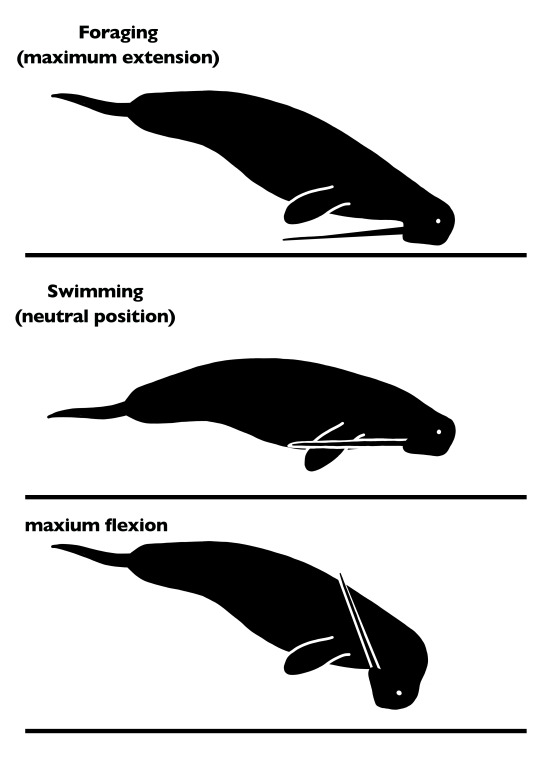
Odobenocetops is a profoundly fucked up whale. The younger species, O. leptodon, had tusks way over a meter in length yet they were too fragile to be used for fighting or digging.
The neck in both species was incredibly flexible as shown above
O. peruvianus lacked a melon and couldn't echolocate, instead relying on binocular vision (O. leptodon had a small melon, which is better than nothing I guess)
and they fed much like walrus, which means they would spit compressed water at the ocean floor to uncover shellfish, grab them with their lips and use their mouth as a vacuum pump to suck out all the soft parts only
oh yeah and some speculate that it might have had whiskers covering its face
1K notes
·
View notes
Text

❤️carnotaurus🦖
#dino art#carnotaurus#paleo art#paleoart#dinosaur#dinosaurs#dinosaur art#digital art#artists on tumblr#carnotaurus art#paleoblr#palaeblr#palaeoart
177 notes
·
View notes
Text
Haemothermia 2: this time its monophyletic
#grigg et al 2022#im still reeling from this#i cant write or read anything else#its 2022 and these motherfuckers are discussing warmbloodedness as a basal amniote trait#palaeblr#palaeontology#paleontology#biology
2 notes
·
View notes
Note
Hello, nice to meet you, Nix! One time, I had an overthought of those two legged theropod dinosaurs being birds themselves due to their feathers and hollow bones, when in actually it's the other way around. Theropod dinosaurs were specially designed reptiles that actually evolved into alternate versions of themselves, and the term "Birds" is their modern name, so birds are living dinosaurs that descended FROM dinosaurs. Few people can be confused, yet that's how evolution works! Am i right?
Yep, it sounds like you’ve got the general idea!
And by understanding that birds are dinosaurs because they descended from dinosaurs, that means you now also understand the basics of how phylogenetic classification works. 👍 Groups of organisms are always part of the same overall group as their ancestors, and everything nests together into a big evolutionary family tree.
#paleontology#palaeblr#evolution#the linked page has turtles in an outdated position btw#but it's a good explanation regardless#Anonymous#asks
24 notes
·
View notes
Text

Something that few people are aware of, but pholidosaurids managed to live for much longer than most know. Although its true that this group peaked around halfway through the Cretaceous (with Sarcosuchus), a paper from 2020 not only extends the record to the Maastrichtian, but also showcases material from Morocco dated to the early Paleocene
But unlike the other three groups, pholidosaurids seem to have gone extinct soon afterwards. That is, unless fossils are found that extend their range yet again.
509 notes
·
View notes
Text
Varanosuchus: First Fossil Croc of 2024
We are two weeks into the year and we already had a bunch of big croc papers, so today I'll cover the first of the two new genera named so far.
Varanosuchus sakonnakhonensis (Monitor lizard crocodile from Sakon Nakhon) is a small atoposaurid neosuchian from the Early Cretaceous of Thailand, a country that has seen a virtual boom in croc papers this past year between the description of Alligator munensis and Antecrocodylus.
Varanosuchus was a small animal, maybe a meter in length if a little longer with a notably short and deep skull and long slender limbs revealing it to have been at least somewhat terrestrial. We actually have a decent amount of material of this guy. The holotype consists of a 3 dimensionally preserved skull as well as assorted postcranial remains (vertebrae, ribs, osteoderms and limbs), there is a second skull of whats likely to be a differently aged individual also showing a 3D skull and well the third ones just a skull table but 2/3 is still great.
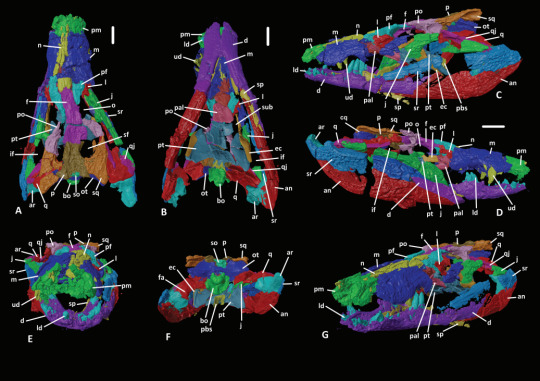

Now this guy was an atoposaurid, which is a group of crocodylomorphs that lived from the Jurassic to the end of the Cretaceous, their last members existing on the island of Hateg some 66 million years ago. Atopsaurids were generally small animals with short snouts and longish legs. Some examples of atoposaurids include Knoetschkesuchus from Germany, Aprosuchus from Romania and Alligatorellus from France and Germany, all three pictured below, art by @knuppitalism-with-ue
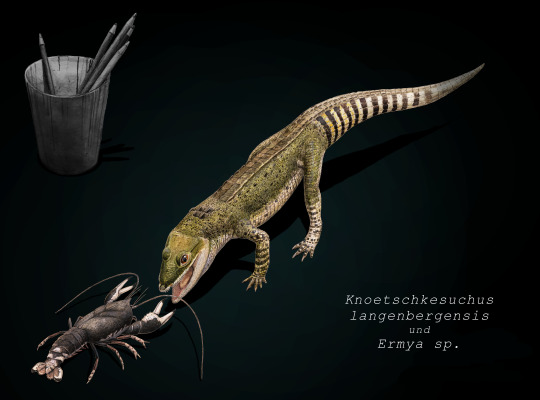
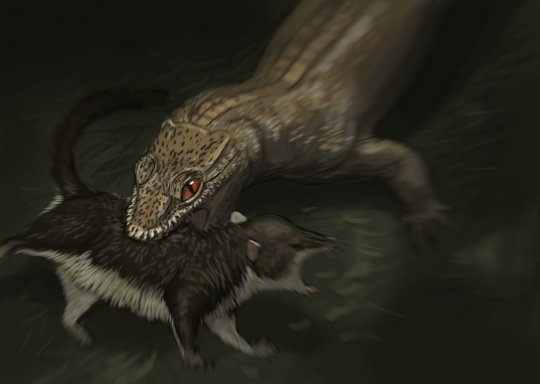
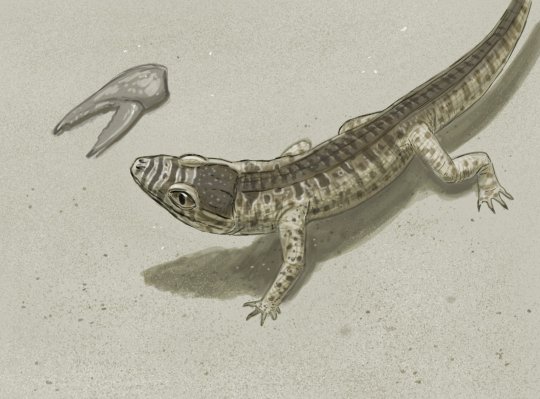
Now the matter of ecology for atoposaurids in general and Varanosuchus in particular is not clear. Altirostral skulls such as that of Varanosuchus are generally associated with terrestrial crocodylomorphs as best examplified by notosuchians. Their teeth and size both obviously speak against being shoreline ambush predators like modern crocs and their legs are straight and slender, suggesting they had an erect posture and not the more sprawling one seen in semi-aquatic forms. Though they could have still had some aquatic affinities. The authors for instance argue that the osteoderms, having plenty of pits, are more like those of an animal that spends time in the water and would thus use them in thermoregulation. So maybe they did enter water from time to time, somewhat like some modern lizards, tho I think its fairly certain that they spend a decent amount of time on land. The artwork below is the reconstruction from the paper itself.
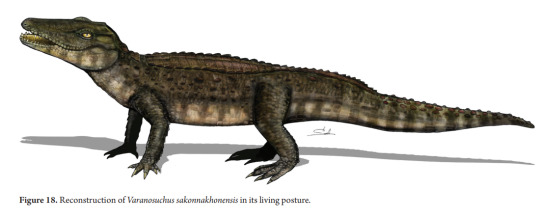
Another matter discussed in the paper is phylogeny, more precisely the relationship of Neosuchians and how Eusuchia is defined. On the first front, its worth noting that the paper recovered both atoposaurids and paralligatorids as monophyletic groups and had them be each others closest relatives, a notion that has been recovered before. More interesting perhaps is the fact that the next closest relatives to these two were hylaeochampsids and Bernissartia, which are typically recovered closer to modern crocs. Which in fact form a separate branch that is the sister group to all the afforementioned clades and taxa. And then you got goniopholids, dyrosaurs and pholidosaurs which are all more basal than the paralligatorid+atoposaurid+crocodilian group, which is back to the ordinary really. The second thing is the definition of Eusuchia. So for the longest time Eusuchia has been defined to include those Neosuchians that have choanae that are fully enclosed by the pterygoid bones (I know I know a bunch of anatomy stuff bear with me). So if the choanae was surrounded by the pterygoid, its an Eusuchian, if not, its more basal. Well, atoposaurids don't have that....BUT VARANOSUCHUS DOES. This, coupled with hylaeochampsids also having this feature and being recovered closer to atoposaurids than to Crocodilians basically suggests that the feature is not diagnostic for Eusuchia and instead appeared multiple times independently.
Moving away from anatomy and phylogeny and all that stuff, I think its very cool that croc research in Thailand has kinda picked up this last year. And fittingly enough some people have even worked on a short documentary covering the known diversity of pseudosuchians from Thailand, giving an overview over the named forms from the Jurassic to today, from titans like Chalawan to even these newest dwarf forms. While the narration is obviously in Thai, there are English subs and I highly recommend looking into it (even if I disagree with their depiction of Varanosuchus as arboreal, its perhaps overshooting the goal a little bit).
youtube
Finally here's the paper itself (tho paywalled)
New Cretaceous neosuchians (Crocodylomorpha) from Thailand bridge the evolutionary history of atoposaurids and paralligatorids | Zoological Journal of the Linnean Society | Oxford Academic (oup.com)
and the wikipedia page I've been working on
Varanosuchus - Wikipedia
I'll try to write up a post on the other new genus, Garzapelta, later this weekend so stay tuned for that.
#varanosuchus#atoposauridae#crocodylomorpha#neosuchia#thailand#cretaeous#pseudosuchia#croc#crocodile#land crocodile#prehistory#paleontology#palaeblr#long post#Youtube
192 notes
·
View notes
Text
HAPPY WORLD CROC DAY
It's June 17th, world crocodile day, a day to appreciate these amazing yet endangered animals. They are my personal favourite group of animals period and just endlessly fascinating to me, both those we have today and those that lived in the ancient past. Tho I'm no professional by any means, I strive to learn about them and spread this knowledge. So here's some photos, art and skeletals of fossil crocs (using the term rather liberally I know).
Feel free to drop your favourites in the reblogs, doesn't matter if extinct or not.

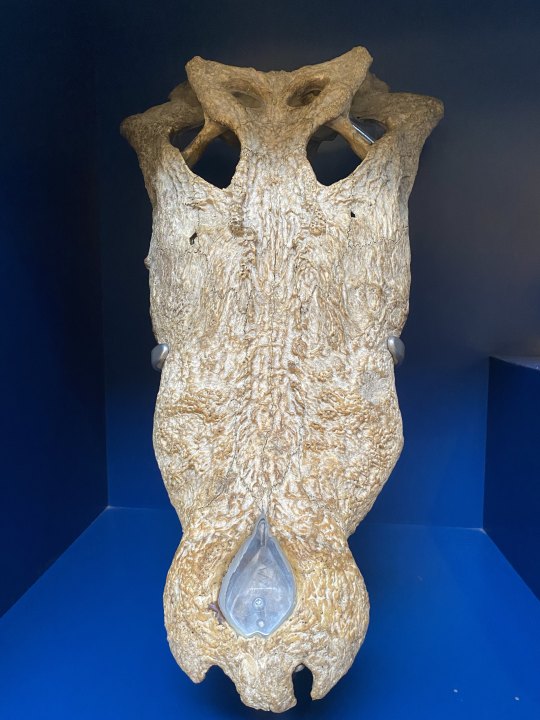
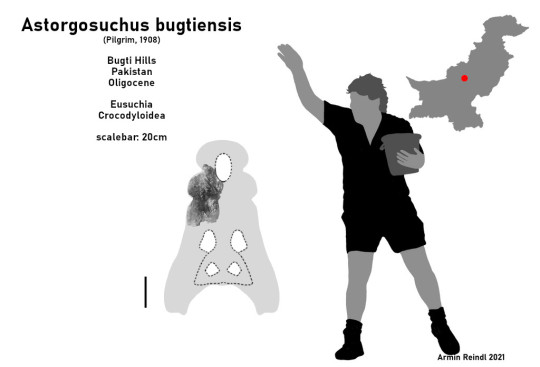
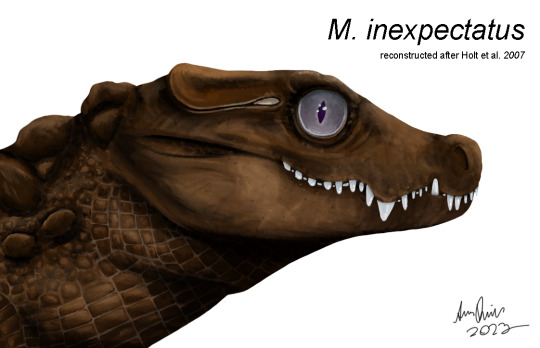

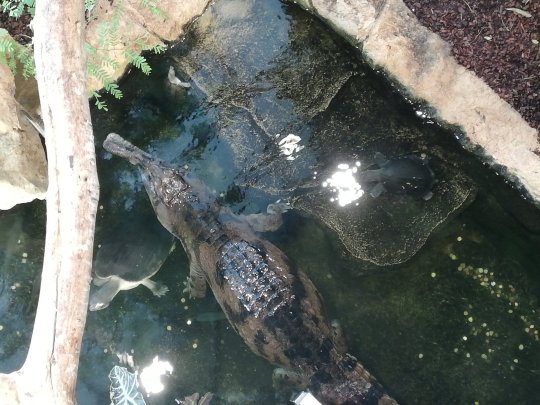




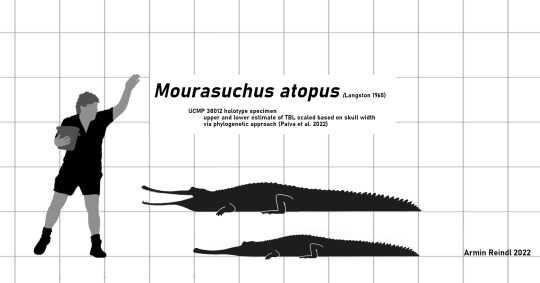
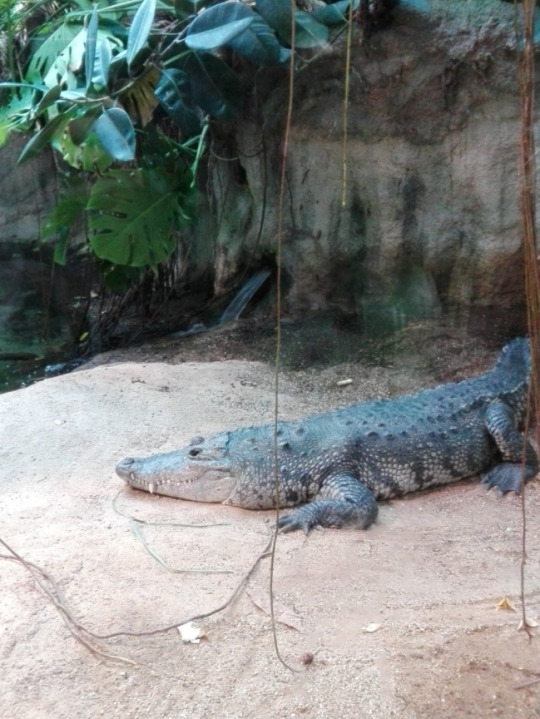
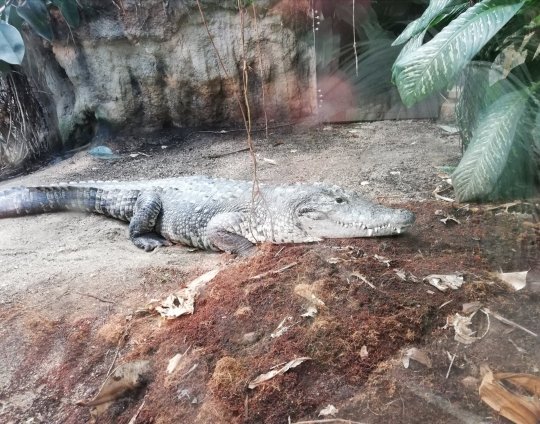
#world crocodile day#crocodile#caiman#gharial#alligator#croc#palaeblr#crocodilian#pseudosuchia#mekosuchus#astorgosuchus#morelets crocodile#dwarf crocodile#tomistoma#mourasuchus#euthecodon
238 notes
·
View notes
Text
So something that a lot of people are seemingly unaware off is the "rostral boss" or simply face bump seen in some American Crocodiles (Crocodylus acutus). I've seen it a few times now that folks are really surprised to see it, so I think its worth sharing a bit on that and its importance to understanding how crocs came to America.
For starters, the rostral boss is a large bump that is located on the snout of some crocodiles just before the eyes, covering the back of the nasal bone and areas of the prefrontals, lacrimals and parts of the frontal bone. This boss, among modern crocs, is most prominent in the American Crocodile. Sidenote, I know its a pain, but here American Crocodile (capitalized C) means Crocodylus acutus. When meaning the crocodiles of America, I'll use Neotropic crocodiles. Also tho I'm usually liberal with the term, here crocodile specifically refers to the genus Crocodylus. Good? Good. Anyhow, this kinda gives them a look thats been likened to the Triassic phytosaurs and makes individuals with said bump really distinct. Below are some pictures which show different indivudals with less and more pronounced bosses.
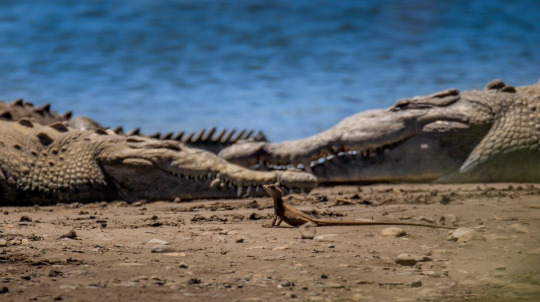





Now this feature is not unique to American Crocodiles (again meaning C. acutus, I know the terminology is confusing), but can be seen in at least some other neotropic Crocodylus species. Now I've yet to see images of either Morelet's or Orinoco Crocodiles with the same and they don't appear to have been recognized with them by older literature, but there are some Cuban Crocodile skulls also showing a slight boss. If you look at the two photos below, you can see an American Crocodile skull on the left and several skulls of Cuban Crocodiles on the right (from the Quaternary Sawmill Sink on the Bahamas). It's comparably subtle in the Cubans, but there is a boss present in these skulls.


The fun part is that this isn't just a random trait that these crocodiles got out of nowhere. No, the rostral boss is actually a trait thats likely to be ancestral to ALL Crocodylus species of the Neotropics (so again, Morelet's, Cubans, Orinocos and Americans). The oldest known Crocodylus species from the Americas is Crocodylus falconensis from the Pliocene of Venezuela. And guess what, it had that very same bump on its face.


But that's not where the trail ends. No. Back in the 1940s a crocodile was found in Miocene sediments of Northern Africa that had a similar bump. Meaning on the other side of the Atlantic. This was largely ignored at the time, despite the similarities to American and Cuban Crocodiles and their rostral bosses being known back then. But more recently, scientists have taken a second look at this species, Crocodylus checchiai, and concluded that it is a likely ancestor to today's Neotropic crocodiles.
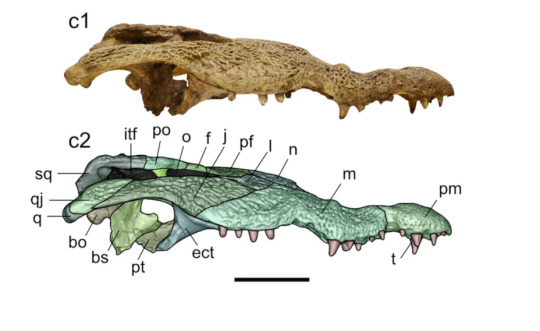

We already knew that African crocodiles (Nile Crocodiles and Sacred Crocodiles) were more closely related to Neotropic crocodiles than to Australasian ones (like Salties, Freshies and Muggers), but this essentially provided some really solid evidence for how crocs got to America. Sometime between the Miocene and Pliocene, Crocodylus checchiai (or a relative or descendent) swam across the Atlantic and landed in the area around the Caribbean, spreading and giving rise to the four true crocodiles that still inhabit the region. Which I personally think is really cool.
#crocodile#crocodiles#american crocodile#evolution#cuban crocodile#morelets crocodile#orinoco crocodile#crocodylus falconensis#crocodylus checchiai#reptiles#crocs#palaeblr
270 notes
·
View notes
Text

MAJOR NEWS FOR CROCODILE FANS
In a newly published paper, Martin et al. describe a new genus of sebecid, Dentaneosuchus from the middle Eocene of France
Whats cool about this animal is not just that its part of a group of terrestrial crocodylomorphs, i.e. croc relatives that lived and hunted on land
But its also enormous
The lower jaw was around 90cm long in the smaller specimen, which puts it in a similar size range as the enormous Barinasuchus from Miocene of South America pictured below (comparisson by Aledgn)
this makes it perhaps the biggest land predator of Europe since the extinction of the dinosaurs.

PS: The paper doesn't go into it much, but among the lower estimates is a mere 3-4 meters. While the proportions are unknown, such a low body length seems rather unlikely given that this would mean the head was a whole third of the whole body. 5 to 6 meters seems a lot more reasonable.
#barinasuchus#dentaneosuchus#sebecidae#eocene#europe#palaeblr#paleontology#crocodile#crocodylomorph#extinct
381 notes
·
View notes
Text
Meiolaniidae
So honestly I'm relatively new to digital painting. I sketched a little here and there, made skeletals, but actual painting I've done very little. But I ended up putting this together for my work on the Wikipedia page for meiolaniid turtles. (Yes the Ninjemys colours are a reference to it being named after the TMNT)
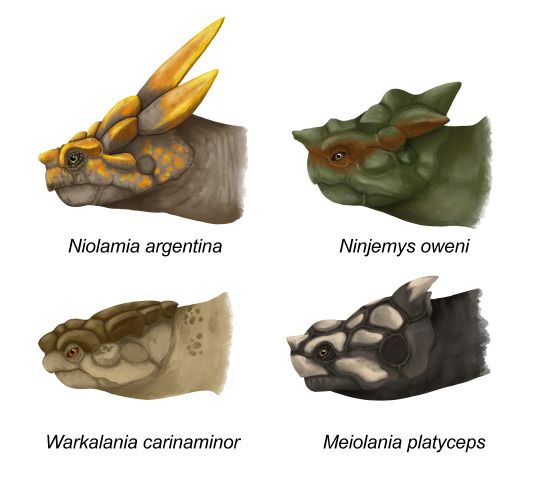
I've rambled a bit about them before, but basically, meiolaniids are weird stem-turtles thought to be outside the two main modern groups we have. They were decently large animals, their shells alone range from 1 meter to 2 meters in length (3 to 6ft I believe?), they were land animals, had some crazy horns and tails that were encased in spiky armored rings and tipped with a tail club.
Here some photos with paleontologist Victoria Arbour, a Ninjemys tail club photographed by Serjoscha Evers and a Meiolania tail club illustrated by W.H. Wesley.
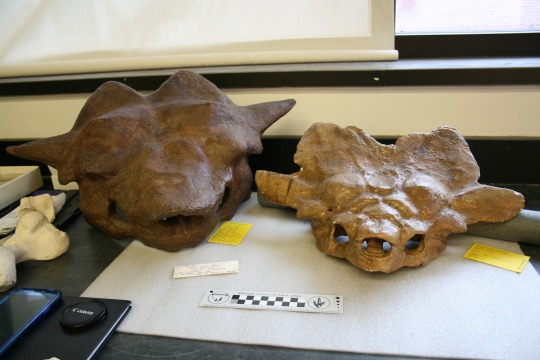
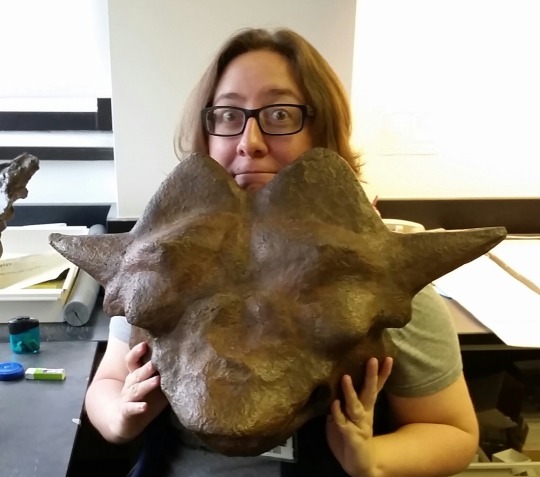
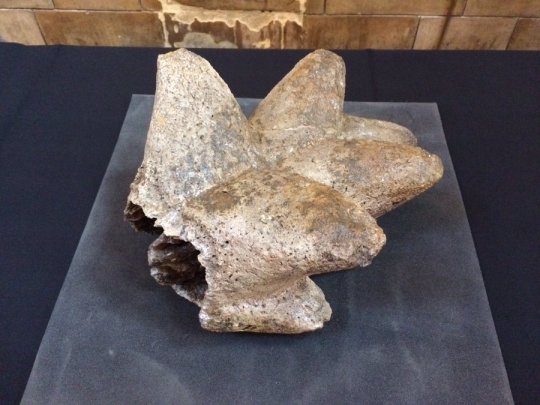

They were found throughout almost the whole Cenozoic, with the oldest form dating to the Eocene of South America and the most recent ones living from the Pleistocene to Holocene in Australia and on various South Pacific Islands.
They are honestly pretty cool animals and super underrated, which is why I decided to give their wikipedia pages upgrades in the first place. Which also meant doing a bunch of other illustrations (that I was more in tune with) and pulling a bunch of public domain photos and putting them on wikimedia.
Here some skeletals and charts I made, open the last pic, it shows multiple different Meiolania species atop each other.
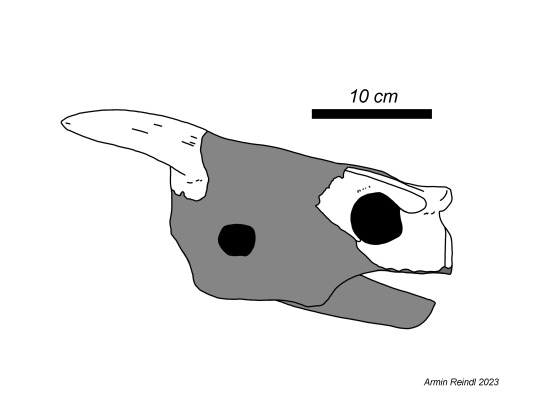

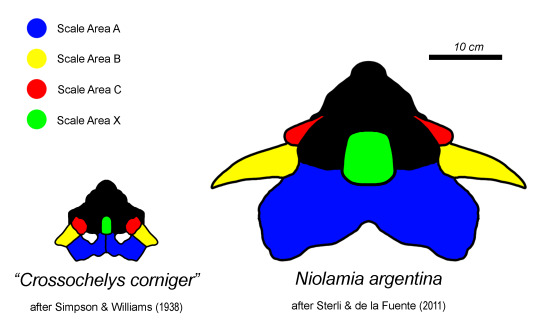

The results were pretty mixed tbh. Some of the most recent forms, Gaffneylania, Warkalania and even Ninjemys had relatively little to write about. But things were more exciting with Niolamia (if you remember my rant about its messed up history). Meiolaniidae itself was just a big summary of all the other stuff, but easily the most extensive was Meiolania itself, which took AGES to research and put togehter. Tho I'm pretty happy with the result. Here's a little side by side, old and new.
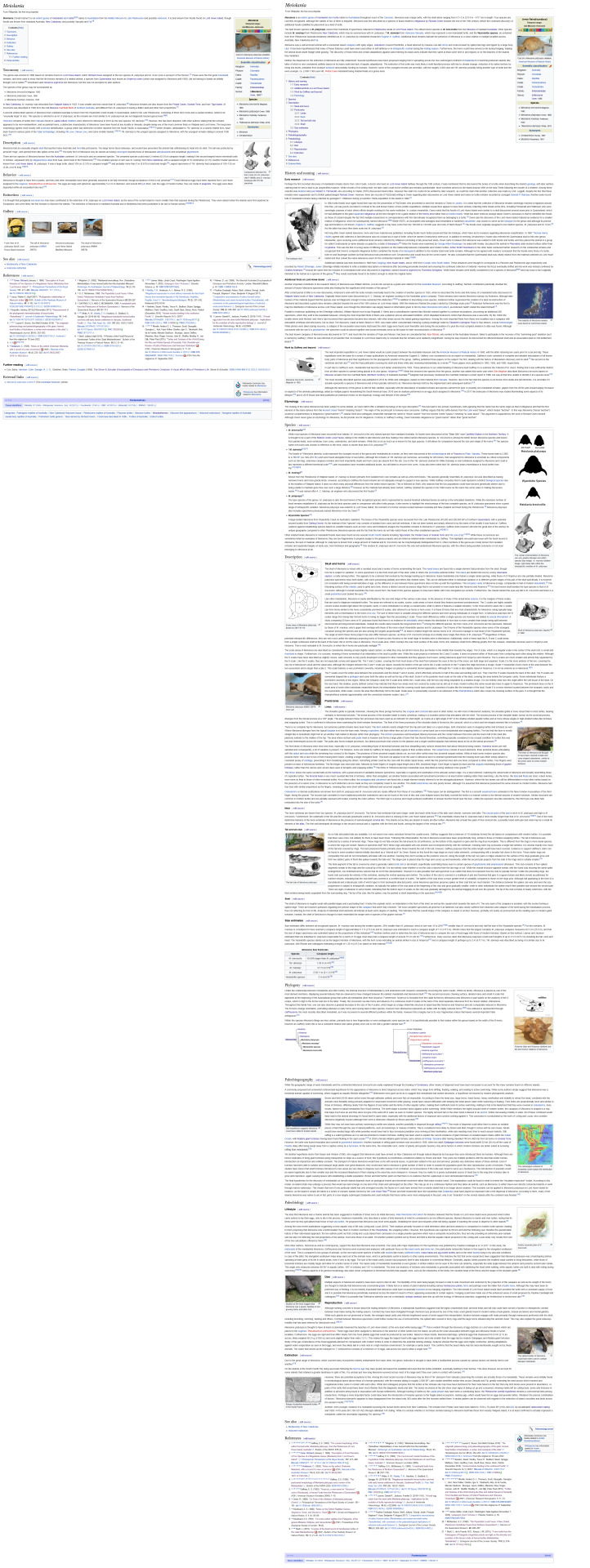
#turtles#wikipedia editing#meiolaniidae#meiolania#niolamia#gaffneylania#ninjemys#teenate mutant ninja turtles#warkalania#tortoise#palaeblr#paleontology#prehistory#australia#argentina#cenozoic#long post#paleo art#skeletal
211 notes
·
View notes
Text


"Paleontology can be really petty and stupid"
In 1898 Santiago Roth discovered the armored tail of a large turtle in Patagonia, which he showed to British paleontologist A.S. Woodward.
Recognizing it as the remains of a meiolaniid, Roth was told to go on an expedition to find more material, which he did.
This material, which included an almost fully preserved skull, was initially published on in a brief communication in 1899.
Strangely, also in 1899, Florentino Ameghino published his own communication claiming that his brother Carlos had found the almost fully preserved skull of that same kind of turtle, a meiolaniid he dubbed Niolamia argentina.
It is curious how both Ameghino and Roth seem to have found the exact same material of a meiolaniid in different localities at the same time, but weirder things have happened. Tho it is further pretty weird how Ameghino rushed to get a name out, but didn't bother describing what defined the animal nor designated a holotype. Hell he didn't even illustrate his skull. But lets give him some time.
Two years pass, its 1901 now. Woodward publishes a proper description of Roth's skull, illustrating the animal in detail. Having heard that Ameghino found a remarkably similar fossil, Woodward assigns the Roth skull to the same species as the Ameghino skull. Although he doesn't carry over the genus Niolamia, instead placing the fossils in Miolania (a misspelling of Meiolania, described a few years prior from Australia). Ameghino didn't seem to mind or disagree, tho he still hadn't properly described nor figured his skull.
1938: Ameghino is dead at this point and weirdly, his Niolamia skull is still nowhere to be found. Since his initial description was wholy insufficient, George Gaylord Simpson (yes thats his actual name) decides to declare the Roth skull the type specimen for Niolamia (the neoptype). Meaning that the genus is now defined on this skull rather than the one Ameghino had when coining the name.
Fast forward to 2011. It is now generally accepted that Roth's skull is the fossil that defines what Niolamia is. Of course Ameghino still gets credit, after all he described the first remains, even tho nobody has ever seen those...ever really. Over a 100 years passed and far as anyone could tell, the last person to have seen those bones were Ameghino and his brother, after which they just disappeared. But we still got the Roth skull, and Juliana Sterli and Marcelo de la Fuente could readily redescribe Niolamia based on that.
But Sterli seems to suspect that something very fishy is going on. Remember, Ameghino just happened to find a perfectly preserved skull at the same time as Roth did. Ameghino made sure to get a name out before Woodward got around to fully describe it. Ameghino only vaguely compared the skull to Meiolania, but didn't specify its unique features nor did he actually illustrate his material. So Sterli said out loud what I'm sure many people must have been thinking.
"Did Ameghino just make it all up?"
In 2015 Sterli comments on the matter by noting how awfully convenient the whole situation was. Although no concrete evidence exists, Sterli suggests that Ameghino may have found out about Roth's skull, lied about having found a similar one, and named Niolamia not on a fossil he actually had but based on what little he knew about Roth's discovery.
This is just a basic summary of a rabbit hole I recently went into and my god its so frustrating on so many levels. Again we don't have concrete evidence that Ameghino's skull didn't actually exist, but the way the timing lined up and the fact that he was in a feude with Francisco Moreno, which has been likened to an Argentinian Bone War, means that this suggestion isn't that out there. It really doesn't help that his supposed skull was only ever mentioned by him in 1899 and never again. Ameghino never claimed it was destroyed or stolen, hell, far as I could find he even agreed with Woodwards research.
What's also fascinating is that seemingly, for over a hundred years, nothing was written in scientific literature casting doubt over his claim. I'm sure some people must have called bullshit on him in private, but the only resource I could find that actually goes as far as to say "Hey isn't his weird that the Ameghino skull is basically a phantom" came out in 2015. Everything in-between seemed content with just assuming that Ameghino and Roth both had skulls and just never followed up on whatever happened to the former. Then again I could just as much understand if people just didn't want to deal with this nightmare of a backstory.
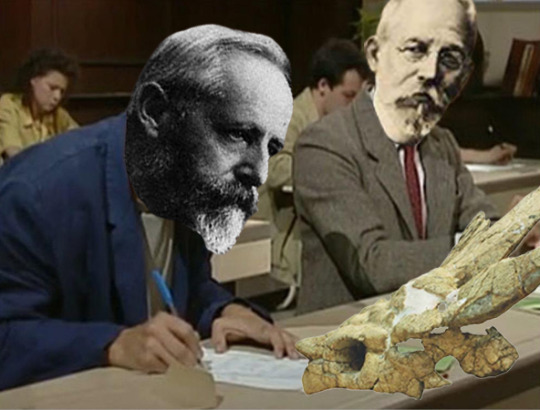
#paleontology#ameghino#florentino ameghino#niolamia#history#prehistory#palaeblr#coproliteposting#meiolaniidae#turtle#paleontology history
262 notes
·
View notes
Text
Prehistoric Planet Croc Ideas
So this was a thing I did on Twitter in anticipation of Prehistoric Planet. Obviously crocs (in this case meaning crocodylomorphs) were a pretty massive part of earth's fauna during the late Cretaceous, and seeing as the first season featured NONE I came to speculate which taxa could hypothetically make an appearance.
Now part of the challenge for myself was to come up with a new, interesting contender every day in anticipation of the show's release, each based around the confirmed episides we had and restricted purely to taxa from the Campanian and Maastrichtian. While it took a lot of energy, I did manage to do so. Hell, halfway through they dropped the reveal of Simosuchus, which I had saved for later.
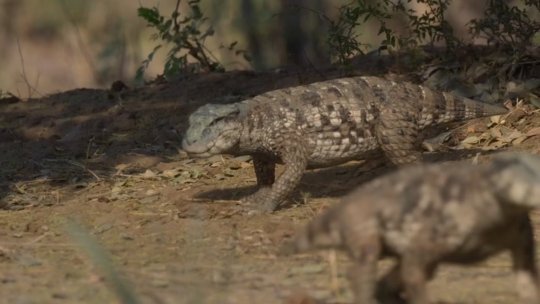
Obviously we didn't get much still, but I'll regardless post my list of candidates and ideas here, perhaps third time's the charme for a lot of these (tho for convenience I'm still ordering them by S2s episode titles). I'll also try to break them apart roughly by biome, starting with islands.
PS: I'd love to hear which crocs people would have loved to see themselves. Any on this list or stuff I didn't even mention? Let me know I'm curious.

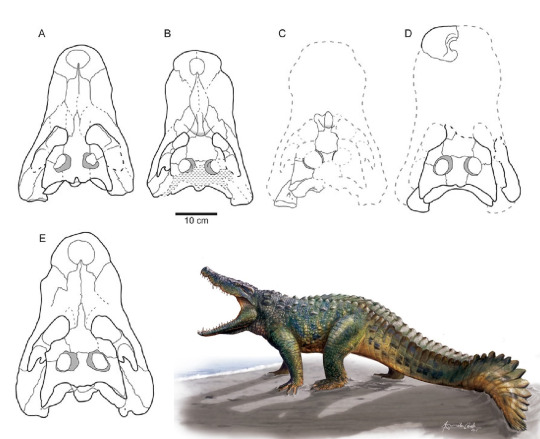

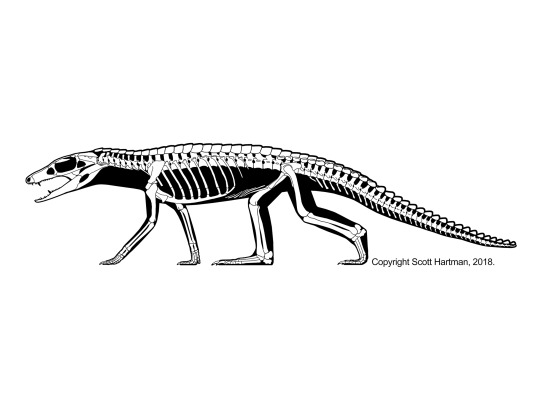

We got a shit ton of island crocs from the Cretaceous actually, which you can broadly divide into two categories.
The crocodiles of the European archipelago as seen in the top row.
Featuring the small, possibly shellfish eating Acynodon (art by Adramelech89), the incredibly widespread Allodaposuchus which did have some possibly semi-terrestrial forms (art by Alejandro Blanco, Aina and Agnès Amblás) and Aprosuchus, a tiny terrestrial critter from Hateg (art by @knuppitalism-with-ue). They already give a nice diversity between tiny durophages with blunt snouts, large, more traditional crocs and lanky land species.
The other island category concerns Madagascar, which had a lot of attention in season 2. Discounting Simosuchus, we got Araripesuchus tsangatsangana (art by Scott Hartman) and Mahajangasuchus (art by Mark Hallet). Both are really cool. The former is yet another smaller terrestrial species that may not actually be part of Araripesuchus, while the later is a massive, 4 meter relative of the famous Kaprosuchus that took to the water independently from all other crocs and has been nicknamed "Hippo croc" for its weird skull. Really I'd have loved to seen an episode entirely dedicated to this place.
Next up we had the badlands episode, which oh boy has a lot of contenders from the clade Notosuchia. Brace yourself.
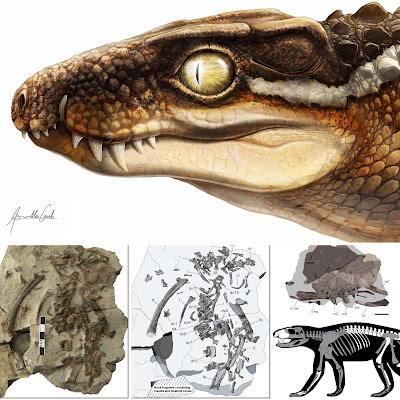


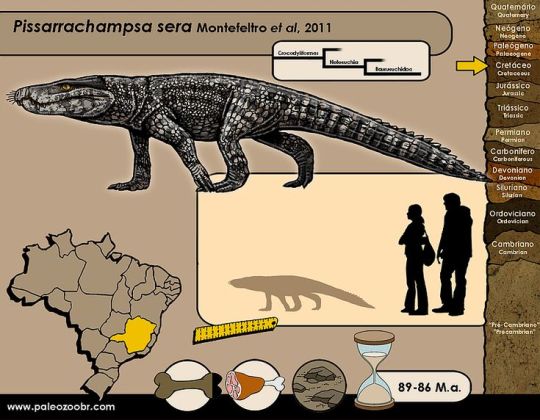


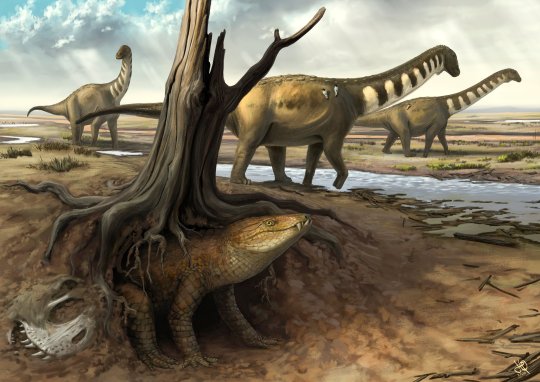

Here again I could split these in two categories.
The first is just general badland taxa. There's Ogresuchus for example, from Spain's Tremp Formation (art by Aina and Agnès Amblás). A relatively small sebecid found in a sauropod nesting site. And we all know what PhP does with baby sauropods. Or the long-necked Gobiosuchus (art by @yoofilos) from Mongolia, which may look like its related to the other ones in this category but actually is a far more ancient type of croc.
The far bigger group concerns South America's Notosuchians. ALL OF THESE are from the Bauru Group, with some even from the same single formation. You got Stratiotosuchus (again by Joschua Knüppe), a large terrestrial baurusuchid that filled the nische of mid sized carnivore in an environment shared by sauropods and abelisaurs. There's Pissarrachampsa (by Felipe Alves Elias), another baurusuchid I decided to feature because we have evidence of a nesting site that shows they only had few eggs. A great opportunity to show their tender side. Uberabasuchus (justin_an74), part of the bizzarly proportioned peirosaurids. Adamantinasuchus (by Deverson da Silva), a small, lanky Notosuchian and of course the heavily armored omnivore Armadillosuchus (by the ever talented Júlia d'Oliveira). Hell you could do a full episode just on the foodweb of the Bauru Group (Godoy et al. 2014).
Then there's swamps, which I'll just use to dump all the crocs that don't fit into the other categories.
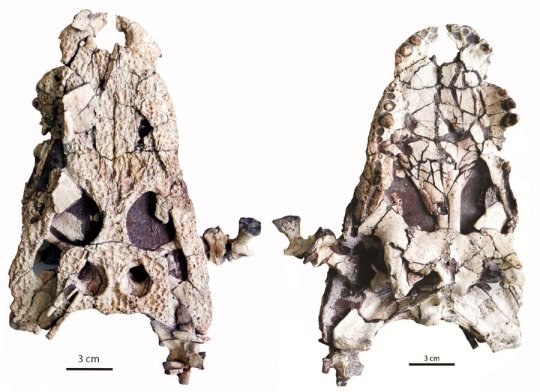


As you'd expect, freshwater would be ideal for crocs with a more traditional semi-aquatic lifestyle, here represented by three forms. Jiangxisuchus (image by Li et al. 2014) is a paralligatorid, which are tiny crocodilians from the Cretaceous and Paleogene of east Asia. We honestly don't know what they are, some say alligator relatives, others say they are closer to crocs. But its small and cute. Then there's Roxochampsa (artist of the model I couldn't find), which looks suspiciously crocodilian but is actually a relative of Uberabasuchus from the badlands, hell it appeared in the same formation. Still, I reasoned that I'd throw it into this category because I already proposed so much for badlands (none of which came true but hey). And then there's Denazinosuchus (art by Andrey Atuchin). Again it looks deceptively like a modern croc, but is actually the last remnant of the goniopholids, crocodyliforms that were prominent animals in the Jurassic and early Cretaceous. It could have brought both taxonomic diversity nad highlighted croc resilience till the end.
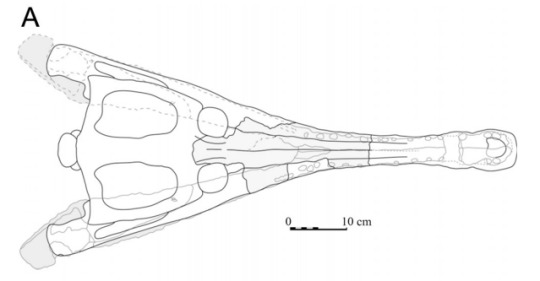

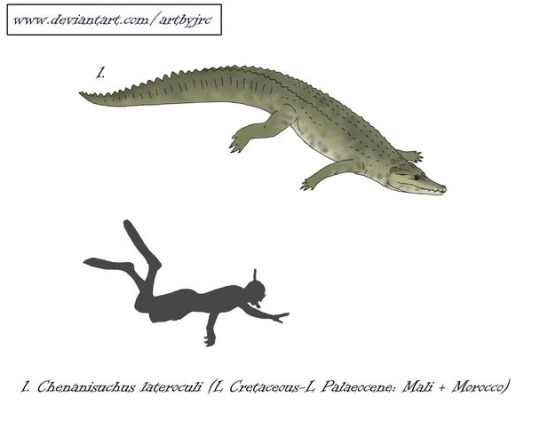
When it came to picking out crocs for Oceans, it got tricky. Obviously season 2 tried to differentiate itself by being set more in the open ocean, not the coast, and true pelagic crocodiles weren't around by the end of the Cretaceous. So I had to settle for coastal animals. There's Sabinosuchus (Schiller II et al. 2016), a cousin to Sarcosuchus and, like Denazinosuchus, one of the last of its lineage. Also its from Mexico which is rarely talked about for its fossils. Rhabdognathus (Ghedoghedo) is a distant cousin, a slender snouted dyrosaur. Unlike pholidosaurs, dyrosaurs actually did really well after the KPG impact and spread around a lot, living way into the Eocene. And finally Chenanisuchus (art by artbyjrc), which like Rhabdognathus was found both before and after the impact that killed the dinosaurs.

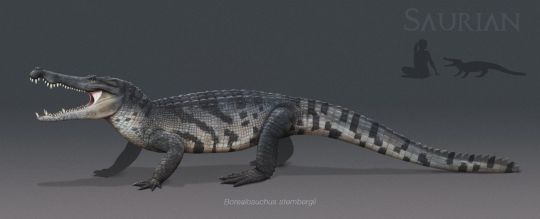
And the final two I shall talk about, both of which I thought/hoped would appear in the North America episode. Again, there's certainly overlap, both would have just as much fit into swamps, while many others would have also suited North America. Regardless, here's Brachychampsa (Tom Parker) and Borealosuchus (Chris Masna), both iconic animals from the Hell Creek Formation. One closely allied with alligators and caimans, the other more basal with a head-shape more similar to todays crocodiles.
Now obviously there'd have been a lot more. Part of the challenge to myself was to try and be as diverse as possible, rather than just listing 10 different baurusuchids I went with only two, tried to include as much of the world as possible, etc.... There's also the fact that some really awesome taxa, Titanochampsa, Brachiosuchus and Eurycephalosuchus, all incredibly unique or interesting, were published too late to have been considered for the show.
And now, in hinsight, we obviously know that with the exception of Simosuchus none of them made it in. Which is a shame, but maybe next time.
#prehistory#palaeblr#crocodile#paleontology#long post#prehistoric planet#prehistoric planet 2#borealosuchus#brachychampsa#simosuchus#pissarrachampsa#stratiotosuchus#gobiosuchus#ogresuchus#uberabasuchus#roxochampsa#armadillosuchus#adamantinasuchus#jiangxisuchus#denazinosuchus#sabinosuchus#rhabdognathus#chenanisuchus#mahajangasuchus#araripesuchus#acynodon#allodaposuchus#aprosuchus
157 notes
·
View notes
Text
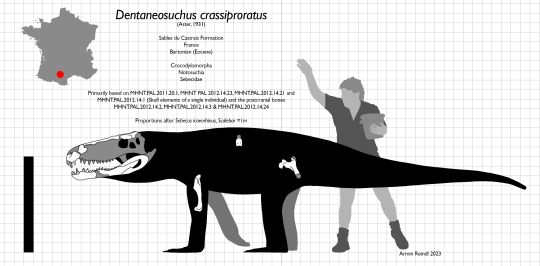
Dentaneosuchus, the new, roughly Barinasuchus-sized sebecid from Eocene France.
Now I wanna prefice this by saying that this is reconstruction is not gospel. Sebecids are a rather poorly known group and there is a lot of guesswork, a lot of unknowns and a lot of things that are subject to change
For instance, I based the outline on Sebecus, but if you used proportions more similar to baurusuchids, you'd get a larger animal (as is often the case with Barinasuchus), so really, while this is meant to give a general idea of the animal, its not infallible and doesn't need to be followed to a T
#dentaneosuchus#palaeblr#skeletal#eocene#paleontology#crocodile#sebecidae#sebecosuchia#notosuchia#land crocodile#barinasuchus
179 notes
·
View notes
Text
Palaelodus, the Swimming Flamingo
Another post for fossil flamingos since I just finished the page yesterday.
Palaelodus is a genus of early flamingo relative belonging to the family Palaelodidae, which can be aptly described as swimming or straight-billed flamingos.


Palaelodids are the sister family to Phoenicopterids, the modern flamingos, and already show a bunch of similarities to them like a deeper bill, long legs and neck and saltglands. Other elements meanwhile are more similar to grebes, which are the closest living relatives to flamingos. This has caused some debate on how Palaelodus would have behaved. Early research proposed that they may have been early filter feeders, but a closer look at the bill shows that they lacked some adaptations that hold the keratinous lamellae in flamingo beaks. Consequently, it has since then been suggested that they fed on insect larvae and snails that live in salt lakes, which may have been an early step for phoenicopteriforms to become filter feeders. The next question regards their legs. Early on people suggested they may have been divers, but that simply didn't make sense due to how strangely long they are. Others suggested wading habits, but their feet are strangely stiff. Mayr's hypothesis seems to make the most sense, arguing that they were swimmers, using stiff webbed feet as paddles.
Megapaloelodus goliath (=Palaelodus goliath?) by Scott Reid
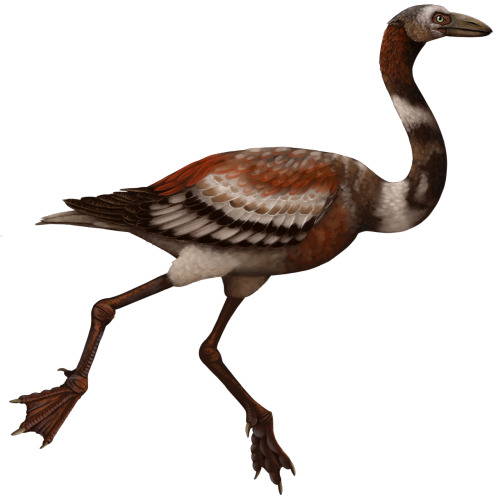
Despite their very different lifestyle, Palaelodus actually had similar habitat preferences to flamingos, inhabiting salty and brackish lakes and having nearly global distribution. The most well known species, Palaelodus ambiguus, Palaelodus gracilipes and Palaelodus crassipes were incredibly common in Oligocene to Miocene Europe, especially France and Germany, the former country having over a thousand bones of them. In France, all three species (which some have suggested is only a single species of varying size) coexisted with the large Megapaloelodus goliath and the true flamingo Harrisonavis.
Images by Alphynix, Ceratops Yuta's Dinosaur Travel Blog and Torres et al. 2015



Outside of Europe, fossils from Brazil are known and tentatively assigned to Palaelodus ambiguus as well. Indetermined palaelodids are known from the early Oligocene of Egypt (Jebel Qatrani Fm), one species named Palaelodus kurochkini stems from Mongolia. Three species are known from Oceania. Palaelodus pledgei and Palaelodus wilsoni are the smallest and largest species respectively, having been found in the Oligocene to Miocene deposits of the Lake Eyre Basin in Australia. A single species, Palaelodus aotearoa, is known from the paleo-Lake Manuherikia in New Zealand, known for its extensive fauna of waterbirds. Much like the European species, the two Australian taxa coexisted with true flamingos, Phoenicopterus novaehollandiae and Phoeniconotius eyrensis.
Palaelodus cf. ambiguus by Felipe Alves Elias, Lake Eyre flamingos by Frank Knight and Palaelodus aetearoa by Tom Simpson

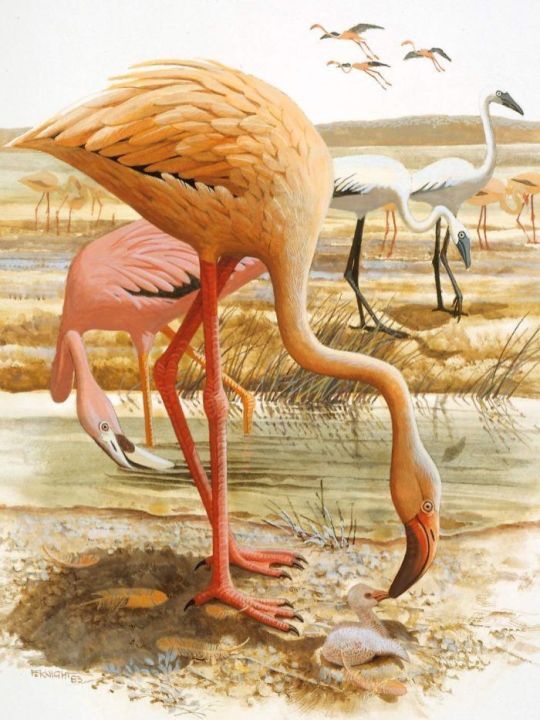
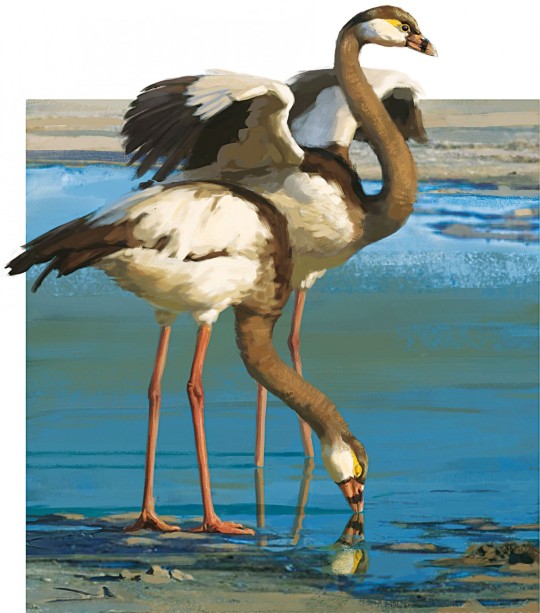
So all things considered, palaelodids and Palaelodus specifically did really well during the Oligocene and Miocene. What happened then is not known as they just disappear from the fossil record, unlike flamingos. Well, mostly disappear from the fossil record. There is one exception. A single isolated bone initially assigned to Palaelodus wilsoni was discovered at Cooper Creek in Australia, indicating an age of no more than 200.000 years. Since then its been suggested that it may not be P. wilsoni or even Palaelodus at all, but from the most recent publication I've seen on it the idea that its a palaelodid is still maintained. I am unsure on this one, as it is a massive gap in the fossil record, but there would be something tragic about it. Assuming that palaelodids survived in Australia, they would have been at home in a place that for a long time was a paradise for flamingos with salt lakes covering whats now the Tirari Desert. And then, during the Pleistocene when Australia got more arid and the lakes dried up, the former diverse flamingo fauna was gone for good, leaving Australia (and Antarctica) the only continents without flamingos, all because of some relatively recent climate change.

As always this is brought to you by me going down a wiki editing rabbit hole, the final result of which can be found here Palaelodus - Wikipedia. That article has all sources and information and then some more stuff that I didn't go in here (like the history and some anatomical lingo) Chances are that Megapaloelodus will be next, at which point I'll have written the pages for all fossil phoenicopterids and palaelodids.
#Palaelodus#Palaelodidae#Flamingos#Phoenicopteridae#fossils#flamingo#wikipedia#wikipedia editing#Palaelodus ambiguus#paleontology#palaeblr#long post
271 notes
·
View notes
Text


Niolamia is a fascinating turtle. Living during the Eocene (probably), it is one of the earliest known meiolaniids.
What makes meiolaniids special is not just that they were sizable land turtles, but two other things
1) The massive horn-like scales, primarily those marked A-C. Niolamia has some of the most impressive ones at that, with the A scale forming an almost ceratopsian-like frill at the back of the head and two large, flattened, side-ways directed horns before said frill.
2) The long tail was armored, covered in bony rings with spikes and in some species even a straight up tail club
The two images above are things I put together for the Wikipedia page of Niolamia.
The first shows the growth of the species. The small skull is a juvenile Niolamia, originally described as Crossochelys but synonymized by later researchers. The bigger skull (to scale) is the neotype (or holotype?) of Niolamia. Check out an older post for some history on that.
The other is a simple sideview of the skull and lower jaw, nothing too fancy.
The bottom two photos aren't mine but those of Victoria Arbour, but show the weirdness and size nicely. The first image shows Niolamia (right) next to Ninjemys (left). While the second picture shows Ninjemys with as I said Victoria Arbour. Which still gives a good idea of how big these animals heads were.
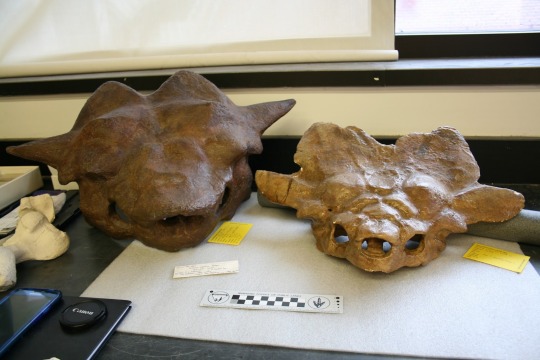
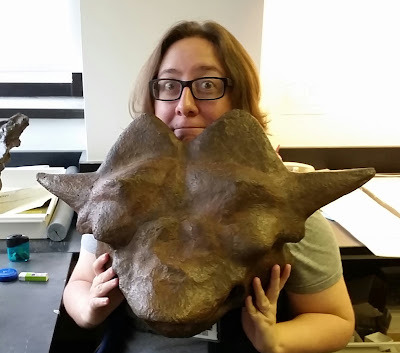
#niolamia#niolamia argentina#paleontology#palaeblr#meiolaniidae#ninjemys#prehistory#turtle#tortoise#extinct#prehistoric
131 notes
·
View notes
Text
Dynatoaetus: Australia's Mighty Eagle
Paleontology news from the land down under, and big ones this time. How big? Well how about one of the largest true birds of prey of Australasia.
Today a new paper was published naming Dynatoaetus gaffae (Gaff's Mighty Eagle), the largest known bird of prey to have ever existed in Australia. Twice the weight of the modern wedge-tailed eagle, it must have been truly an imposing animal to behold, in the Australasian realm second only to the enormous Haast's eagle of New Zealand.
Comparisson below by Ellen K. Mather

But the name is a bit of a missnomer, well sorta. You see, while its referred to as an eagle, phylogenetic analysis shows that the closest living relatives of Dynatoaetus are actually aegypiine vultures. Or in simpler terms, those old world vultures known for their mostly naked necks such as lapett-faced vultures, hooded vultures and griffon vultures. Below some examples of this group by yours truly.

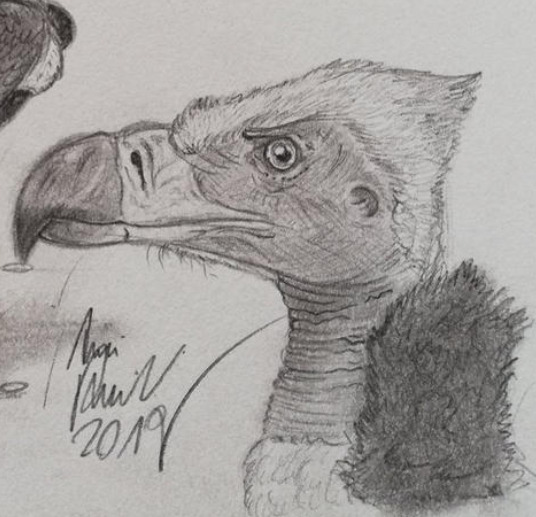

At the same time tho, despite being related to these vultures, Dynatoaetus didn't act like one. In this regard eagle is an appropriate term, more indicative of a lifestyle and morphology rather than relation (seeing as sea eagles relate to kites and philippine eagles are closer to these vultures than "real" eagles). With really robust hindlimbs and powerful talons, Dynatoaetus is more suited to capturing and incapacitating struggling live prey than it is to simply scavening dead bodies. And with Australia's megafauna offering a wide range of kangaroos, giant wombats and flightless birds it hat a lot to choose from.
Of course a bird of this size would not be above scavening either and with its power and bulk it could easily dominate carcasses when in conflict with the smaller Cryptogyps. Overall this lifestyle appears similar to what we see today in wedge-tailed eagles, which are formidable hunters but also opportunistic scavengers. Mather and colleagues even go as far as to suggest that the role of generalist apex predator was initially filled by Dynatoaetus and wedge-tails only managed to take up this nische after the former went extinct some 50k years ago along with most of Australias native fauna.
If you want an idea of things, here's some pictures of wedge-tailed eagles doing their thing. Now imagine what that would be like at twice the size.
images by Clive Roper and Scott Bell
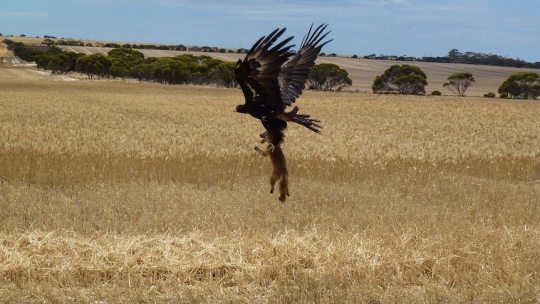

As per usual with these posts, here is the Wikipedia page I set up. Keep in mind the skeletal there shows the known material, but does not accurately represent the real proportions as its simply a colored griffon vulture. And the paper itself, its open access and gives more detail than I ever could.
Dynatoaetus - Wikipedia
A giant raptor (Aves: Accipitridae) from the Pleistocene of southern Australia | SpringerLink
And since you made it this far, here's a reward....or punishment? Idk depends but once I heard its name meant "mighty eagle" I couldn't get this goddamn clip out of my head and so you shall suffer with me.
#paleontology#palaeblr#eagle#birds of prey#vulture#Dynatoaetus#pleistocene#australia#giant eagle#fossil#prehistory#extinct animals#wedge tailed eagle
93 notes
·
View notes